 W
WA.P. Indy was an American Thoroughbred racehorse who won the Belmont Stakes and Breeders' Cup Classic on his way to American Horse of the Year honors in 1992. His time in the Belmont Stakes tied Easy Goer for the second-fastest running in the history of the race, behind his damsire Secretariat.
 W
WAmbiorix (1946–1975) was a French Champion Two-Year-Old Thoroughbred racehorse who became a leading sire.
 W
WAmerican Eclipse (1814–1847) was an undefeated American Thoroughbred racehorse, who raced when three- to four-mile heats were common.
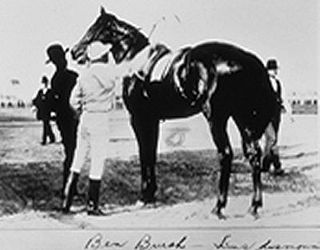 W
WBen Brush (1893–1918) was a high-class Thoroughbred racehorse and sire who won the 1896 Kentucky Derby. He was a bay stallion by Bramble out of Roseville by Reform. Ben Brush was bred at Runnymead Farm.
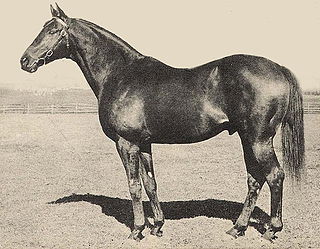 W
WBimelech was a champion Thoroughbred racehorse who won two Triple Crown races and was a Champion at both age two and three. He was ranked #84 among U.S. racehorses of the 20th century. After retiring to stud, he sired 30 stakes winners and his daughters produced 50 stakes winners.
 W
WBlenheim (1927–1958), also known as Blenheim II, was a British Thoroughbred race horse who won The Derby in 1930. As sire, he had a major influence on pedigrees around the world. Blenheim was highly tried, by European standards, as a two-year-old in 1929, winning four of his seven races. In the following season he was beaten in his first two races before recording an upset 18/1 win in the Derby. His racing career was ended by injury soon afterwards, and he was retired to stud, where he became an extremely successful and influential breeding stallion, both in Europe and North America.
 W
WBoston (1833–1850) was an outstanding Thoroughbred racehorse and a Leading sire in North America three times from 1851 to 1853. He started in about 45 races, winning 40, including 15 in succession. Boston was later one of the initial inductees into the Hall of Fame.
 W
WBroomstick (1901–1931) was a Thoroughbred race horse whose most important win was in the 1904 Travers Stakes. After retirement, he became one of the great sires in American racing history, leading the North American sire list in 1913, 1914 and 1915. He was inducted into the National Museum of Racing and Hall of Fame in 1956.
 W
WBull Dog (1927–1954) was a French Thoroughbred racehorse who became a North American Champion sire and Champion broodmare sire.
 W
WBull Lea was an American Thoroughbred racehorse who is best known as the foundation sire responsible for making Calumet Farm one of the most successful racing stables in American history. In their article on Calumet Farm, the International Museum of the Horse in Lexington, Kentucky wrote that Bull Lea was "one of the greatest sires in Thoroughbred breeding history."
 W
WChance Play was an American Champion Thoroughbred racehorse and Champion sire. In a career which lasted from 1925 to 1928 he ran in thirty-nine races and won sixteen of them. Although he was successful in his early career over sprint distances, he did not reach his peak until the age of four in 1927, when he was arguably the best horse in the United States, winning several major races including the two-mile Jockey Club Gold Cup.
 W
WCommando (1898–1905) was an American Hall of Fame Champion Thoroughbred racehorse.
 W
WCount Fleet was a champion American thoroughbred racehorse. In 1943, he became the sixth American Triple Crown winner when he won the Belmont Stakes by a then record margin of twenty-five lengths. After an undefeated season, he was named the 1943 Horse of the Year and champion three-year-old. Also a champion at age two, he is ranked as one of the greatest American racehorses of the twentieth century. He was inducted into the National Museum of Racing and Hall of Fame in 1961.
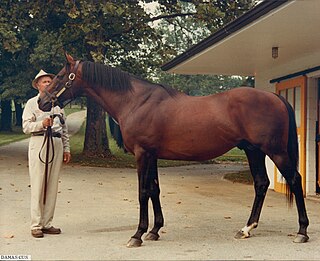 W
WDamascus was a Thoroughbred race horse sired by Sword Dancer out of Kerala foaled at the Jonabell Farm in Lexington, Kentucky. In 1967, he won the Preakness Stakes, Belmont Stakes*, Jockey Club Gold Cup*, Wood Memorial, Travers Stakes, Dwyer Stakes, and Woodward Stakes and was named Horse of the Year and champion three-year-old colt, plus he shared the champion handicap male honors with Buckpasser. Also in 1967, Damascus finished third in the 1967 Kentucky Derby. A high-strung horse, he was enervated by the humidity and spooked by the crowd noise, so he was thereafter given a stable pony to calm him. During the same year, top horses Dr. Fager and Buckpasser were also competing. In Blood-Horse magazine's top 100 U.S. thoroughbred champions of the 20th Century, Buckpasser ranks 14th and Dr. Fager ranks 6th. In a race many consider the "Race of the Century," Damascus won the 1967 Woodward by 10 lengths over both of these horses after his connections, as well as those of Buckpasser, used stablemates to set a blistering pace, thus weakening Dr. Fager. Damascus himself ranks number 16 in the Blood Horse listing.
 W
WDiomed, foaled in 1777, was an English Thoroughbred race horse who won the inaugural running of The Derby in 1780. He was subsequently a successful sire in the United States.
 W
WDistorted Humor is an American Thoroughbred racehorse and a successful sire.
 W
WDomino (1891–1897) was a 19th-century American thoroughbred race horse.
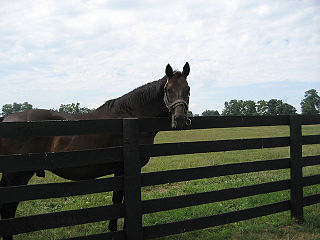 W
WDynaformer was a Thoroughbred race horse and breeding stallion most notable as the sire of 2006 Kentucky Derby winner Barbaro.
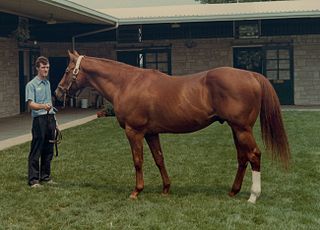 W
WExclusive Native was an American Thoroughbred racehorse who won the Sanford Stakes and Arlington Classic. He is best known as the sire of Triple Crown winner Affirmed, who helped Exclusive Native become the leading sire in North America of 1978 and 1979.
 W
WFair Play was an American-bred Thoroughbred racehorse who was successful on the track, but even more so when retired to stud. He is best known as the sire of Man o' War, widely considered one of the greatest American racehorses of all time. On the racetrack, Fair Play was known for his rivalry with the undefeated Colin, to whom he finished second in the Belmont Stakes. Later, Fair Play was the leading sire in North America of 1920, 1924 and 1927, and the leading broodmare sire of 1931, 1934 and 1938. He was inducted into the National Museum of Racing and Hall of Fame in 1956.
 W
WGallant Man was a thoroughbred racehorse, named for a horse in a Don Ameche movie. He was one of the most successful racehorses foaled outside the United States with his near miss in the 1957 Kentucky Derby and his record 1957 Belmont Stakes win. His exact foaling date was unknown or at best debated over the years of his life and many years after. The supporting evidence from a review of foaling stall records in Ireland indicates that he was born on the Saturday after St. Patrick's Day during a highly productive foaling weekend for many thoroughbred mothers on the same farm. His dam, Majideh, is recorded as being in the foaling stall without a live foal until March 20, 1954, at approximately 7:45 am.
 W
WGlencoe (1831–1857) was a British bred Thoroughbred racehorse, who won the 2,000 Guineas Stakes and the Ascot Gold Cup. He was one of the earliest Thoroughbred stallions imported into the United States and was a top broodmare sire there. Several outstanding sons of Lexington were out of Glencoe mares, including Asteroid, Kentucky and Norfolk.
 W
WGulch was an American thoroughbred racehorse and sire. Owned and bred by Peter M. Brant, he was sired by the outstanding North American stud and graded stakes race winner Mr. Prospector out of the graded stakes race winning Rambunctious mare Jameela.
 W
WHamburg (1895–1915) was an American Thoroughbred race horse. The leading American colt of his generation, Hamburg was retrospectively named the American Horse of the Year for 1898. After his racing career he went on to be a successful sire.
 W
WHanover (1884–1899) was a champion American Thoroughbred racehorse that won his first 17 race starts. He was the last American stallion to head the leading sire in North America list for four consecutive years until Bold Ruler did so in 1965.
 W
WHimyar was an American Thoroughbred racehorse and sire. Although successful as a racehorse he is most notable as the sire of 1898 Kentucky Derby winner Plaudit and Domino, the grandsire of Colin and Peter Pan. Himyar lived to be thirty years old, outliving both Domino and his famous grandson Commando, who both died young.
 W
WInto Mischief is a retired American Thoroughbred racehorse and active sire. During his racing career, he won three of six starts including the CashCall Futurity. Since his retirement, he has developed into an outstanding sire, leading the North American sire list in 2019. He is the sire of 2020 Kentucky Derby and 2020 Breeders' Cup Classic winner Authentic.
 W
WKingston (1884–1912) was an American Thoroughbred racehorse. He won 89 races, the most in the history of the sport of Thoroughbred racing. Of his 138 starts, he was out of the money only on four occasions. He was later inducted into the United States Racing Hall of Fame.
 W
WLeamington (1853–1878) was a Thoroughbred racehorse, and an influential sire in the United States during the second half of the nineteenth century. He was not only a fast horse, but also showed great staying ability.
 W
WLexington was a United States Thoroughbred race horse who won six of his seven race starts. Perhaps his greatest fame came however as the most successful sire of the second half of the nineteenth century; he was the leading sire in North America 16 times, and broodmare sire of many notable racehorses.
 W
WLyphard was a French Thoroughbred racehorse and an important sire.
 W
WMahmoud (1933–1962) was a French-bred, British-trained Thoroughbred racehorse and sire. In a career which lasted from April 1935 to September 1936 he ran eleven times and won four races. In 1935 he won two of Britain's most important two-year-old races and was officially rated the second best colt of his generation. In 1936 he won only once from five starts, but this win came in The Derby in which he set a race record which stood for fifty-nine years, and became the third of only four greys to win the race. After being retired from racing he was sold and exported to the United States, where he became a highly successful breeding stallion and was America's Champion sire in 1946.
 W
WMan o' War was an American Thoroughbred who is widely considered one of the greatest racehorses of all time. Several sports publications, including The Blood-Horse, Sports Illustrated, ESPN, and the (AP) Associated Press, voted Man o' War as the outstanding horse of the 20th century. During his racing career, just after World War I, Man o' War won 20 of 21 races and $249,465 in purses. He was the unofficial 1920 American horse of the year and was honored with Babe Ruth as the outstanding athlete of the year by The New York Times. He was inducted into the National Museum of Racing and Hall of Fame in 1957. On March 29, 2017, the museum opened a special exhibit in his honor, "Man o' War at 100".
 W
WMessenger was an English Thoroughbred stallion bred by Richard Grosvenor, and imported into the newly-formed United States of America just after the American Revolution.
 W
WMr. Prospector was a Thoroughbred racehorse who became an outstanding breeding stallion and notable sire of sires. A sprinter whose career was cut short by repeated injuries, he won seven of his 14 starts, including the Gravesend Handicap at Aqueduct Racetrack and the Whirlaway Handicap at Garden State Park.
 W
WNative Dancer, nicknamed the Gray Ghost, was one of the most celebrated and accomplished Thoroughbred racehorses in American history and was the first horse made famous through the medium of television. He was a champion in each of his three years of racing, and was inducted into the National Museum of Racing and Hall of Fame in 1963. In the Blood-Horse magazine List of the Top 100 Racehorses of the 20th Century, he was ranked seventh.
 W
WNijinsky, usually known in the United States as Nijinsky II, was a Canadian-bred, Irish-trained Thoroughbred racehorse and sire. He was the outstanding two-year-old in Europe in 1969 when he was unbeaten in five races. In the following season, he became the first horse for thirty-five years to win the English Triple Crown, a feat that had not been repeated as of 2020. He is regarded by many experts to have been the greatest flat racehorse in Europe during the 20th century.
 W
WNorthern Dancer was a Thoroughbred who in 1964 became the first Canadian-bred horse to win the Kentucky Derby. He then became one of the most successful sires of the 20th century. He is considered a Canadian icon, and was inducted into the Canadian Sports Hall of Fame in 1965. Induction into the Racing Hall of Fame in both Canada and the United States followed in 1976. As a competitor, The Blood-Horse ranked him as one of the top 100 U.S. Thoroughbred racehorses of the 20th century. As a sire of sires, his impact on the breed is still felt worldwide.
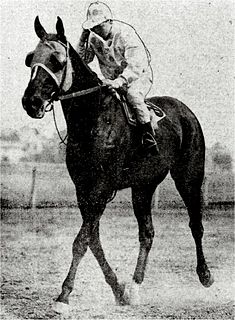 W
WPeter Pan (1904–1933) was an American Thoroughbred racehorse and sire, bred and raced by prominent horseman, James R. Keene. As winner of the Belmont Stakes, the Brooklyn Derby and the Brighton Handicap, he was later inducted into the National Museum of Racing and Hall of Fame. His progeny included many famous American racehorses, including several winners of the Kentucky Derby and the Preakness Stakes.
 W
WRaise a Native was an undefeated Thoroughbred racehorse that was named 1963 champion two-year-old colt in the Turf and Sport Digest poll and was the highest rated juvenile in the Experimental Free Handicap. He sired 74 stakes winners, including Majestic Prince and Alydar. In its 1988 obituary for the horse, The New York Times called him "the most influential sire of American Thoroughbred stallions over the last 20 years".
 W
WRound Table was an American Thoroughbred Hall of Fame racehorse. He is considered the greatest turf horse in American racing history.
 W
WSeattle Slew was an American Thoroughbred race horse who won the Triple Crown in 1977 — the tenth of thirteen horses to accomplish the feat. He is one of two horses to have won the Triple Crown while having been undefeated in any previous race; the second was Justify, who won the Triple Crown in 2018 and who is descended from Seattle Slew. Honored as the 1977 Horse of the Year, he was also a champion at ages two, three, and four. In the Blood-Horse magazine List of the Top 100 U.S. Racehorses of the 20th Century Seattle Slew was ranked ninth.
 W
WSickle was a British-bred thoroughbred racehorse who was later exported to the US where he was twice the leading sire in North America. He was bred by Edward Stanley, 17th Earl of Derby.
 W
WSir Archy was an American Thoroughbred racehorse considered one of the best racehorses of his time and later one of the most important sires in American history. He was inducted into the National Museum of Racing and Hall of Fame in the inaugural class of 1955.
 W
WSir Gallahad (1920–1949) was a French Thoroughbred racehorse and a very important Sire in the United States.
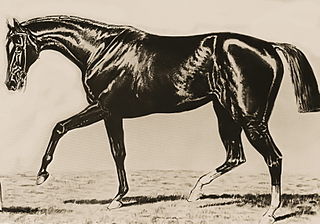 W
WSpendthrift was a successful American Thoroughbred racehorse and an outstanding sire.
 W
WStar Shoot was a Thoroughbred racehorse that was bred in Ireland, raced in the United Kingdom and was eventually imported to the United States to become a five-time leading sire in the early 1900s. He was a white stockinged, chestnut colt sired by the great British 1893 Triple Crown winner, Isinglass, out of the Hermit bred mare Astrology. He is best remembered for siring the American Classic winning sons Sir Barton and Grey Lag and the 1917 American Oaks winning filly Wistful I.
 W
WThunder Gulch was a Champion American Thoroughbred racehorse best known for his wins in the Kentucky Derby and the Belmont Stakes in 1995, which earned him the title of U.S. Champion 3-Yr-Old Colt.
 W
WTiznow is an American Thoroughbred racehorse best known for his wins in the Breeders' Cup Classic in 2000 and 2001, becoming the only horse to win this race twice. He was the 2000 American Horse of the Year and was inducted into the National Museum of Racing and Hall of Fame in 2009.
 W
WTom Fool was an American Thoroughbred racehorse, a winner of the American Horse of the Year award and a Hall of Fame inductee. He sired the outstanding racehorses Buckpasser and Tim Tam.
 W
WWar Admiral was an American Thoroughbred racehorse, best known as the fourth winner of the American Triple Crown and Horse of the Year in 1937, and rival of Seabiscuit in the 'Match Race of the Century' in 1938. During his career toward the end of the Great Depression, War Admiral won 21 of his 26 starts with earnings of $273,240 After his retirement to stud, he was the leading sire in North America for 1945 and was also an outstanding broodmare sire whose influence is still felt today in descendants such as American Pharoah and Justify.
 W
WWhisk Broom II (1907–1928) was an American-bred Thoroughbred racehorse who raced in the United Kingdom and in the United States. Whisk Broom showed high class form during four seasons of racing in Europe, but produced his best performances when returning to America in 1913. He claimed the New York Handicap Triple by winning the Metropolitan Handicap, the Brooklyn Handicap, and the Suburban Handicap, a feat unmatched until Tom Fool achieved it forty years later. Kelso in 1961 and Fit To Fight in 1984 later joined them as the only other horses to win the Handicap Triple. Whisk Broom II's career was ended by injury after his triple success, but he went on to become a successful breeding stallion.